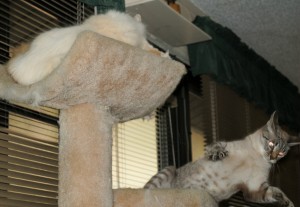 Message from Lucy: How would you like to go to sleep and wake up to find your toenails , fingernails and the ends of your toes and fingers missing? I don’t know about you but I use mine. Ok, maybe sometimes I forget and take a swipe or two – or three at Mom’s sofa, but my nails are important. I use them to climb my cat tower; I really need them to put my scent on things to warn off Maggie, that obnoxious Bulldog. Most of all, my claws help me to balance and break falls. If I should sneak out the door, my claws would allow me to climb a tree to hide from the bad guys. If I didn’t have my claws, I wouldn’t be able to defend myself against fatso Bella. (She doesn’t have claws but she’s a beast, and I need to flex my claws sometimes to remind her that I’m the boss. (Like the day I tried to slash Bella when she stole the top perch on “my” cat tree and she knocked me off the tree)
Message from Lucy: How would you like to go to sleep and wake up to find your toenails , fingernails and the ends of your toes and fingers missing? I don’t know about you but I use mine. Ok, maybe sometimes I forget and take a swipe or two – or three at Mom’s sofa, but my nails are important. I use them to climb my cat tower; I really need them to put my scent on things to warn off Maggie, that obnoxious Bulldog. Most of all, my claws help me to balance and break falls. If I should sneak out the door, my claws would allow me to climb a tree to hide from the bad guys. If I didn’t have my claws, I wouldn’t be able to defend myself against fatso Bella. (She doesn’t have claws but she’s a beast, and I need to flex my claws sometimes to remind her that I’m the boss. (Like the day I tried to slash Bella when she stole the top perch on “my” cat tree and she knocked me off the tree)
If you have been considering declawing your cat or kitten, you need to know certain facts. Declawing is not a mani-pedi. This is major surgery on a cat. Declawing is amputation of the last joint of the cat’s toes. On humans, that would be like cutting off every finger at the last knuckle. Recovery is painful and infections are common.
Declawing a cat is against the law in many countries. Unfortunately, the United States is not one of those, though many American veterinarians refuse to do the surgery.
Declawing can create more problems in some cats. For example, cats whose claws have been removed may have litter box issues. The pain from the surgery may prevent them from digging in the box, and they may choose other places in the house as their bathroom. Some cats develop psychological problems after declawing. Joint stiffness is common.
Cats are adept at hiding pain. In the wild, a cat displaying pain would be at risk to predators and instinct tells them to hide that weakness. But make no mistake: declawing hurts.
A more humane approach is to train your cat not to scratch the sofa. Provide Fluffy with a good scratching post and commit to the time it takes to train her to use it. When you catch her using her claws on something she shouldn’t, carry her straight to the scratching post and place her in front of it. Lift her paws and mimic the scratching motion in the proper area. Then give her a treat and praise her. She will learn quickly that scratching on that post means a treat. Do not punish her. It doesn’t help.
Trim Fluffy’s claws every week or 10 days. If the problem persists, you might try Soft Paws, a product that you glue on to the cat’s toenails. They are easy to apply and last 4-6 weeks. When she scratches with the Soft Paws in place, it won’t cause any damage.
 Copyright secured by Digiprove © 2011
Copyright secured by Digiprove © 2011




{ 0 comments… add one now }